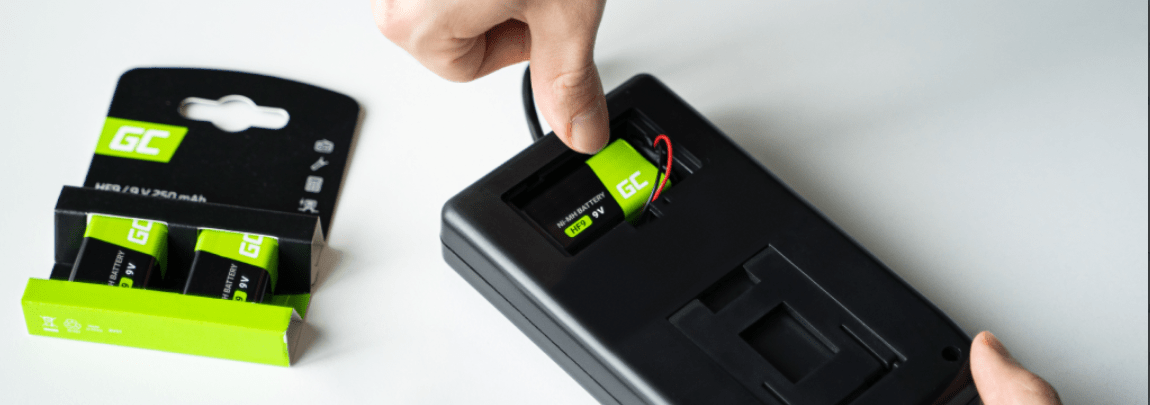You can find a variety of battery types nowadays, and each variant can be used for other purposes. Some of them come as rechargeable products. This is also the case with 9V. What are these batteries and how can you replenish them?
In this article you will find out:
- what’s so special about 9V batteries,
- how you can use them,
- how to recharge 9V batteries.
What are 9V batteries?
9V batteries appeared as the radio became increasingly popular. These batteries were probably designed by a company known as Eveready, which is now owned by Energizer. The first models appeared in 1956. You might have guessed by now that these batteries come with a voltage of 9V. They are usually made of 6 AAAA cells linked in a string and closed in a metal case.
The battery comes in a characteristic cuboid shape and its size is 48.5 x 26.2 x 17 mm. It may come in a number of variants with different capacity:
- 6LR61 alkaline batteries with a capacity of ca. 565 mAh,
- 6F22 Zinc-carbon batteries with a capacity of ca. 400 mAh,
- ER9V Lithium batteries with a capacity of ca. 1200 mAh
- rechargeable NiMH batteries with a capacity of ca. 250 mAh,
- rechargeable Lithium-Ion batteries with a capacity of ca. 500 mAh.
The above designations are characteristic for 9V batteries, but there are actually many more, e.g. HF9, R20, 6HR61, PP3, MN1604.


What are 9V batteries useful for?
At the moment 9V batteries are not particularly popular. They are used mainly in small household appliances, such as clocks, radios, scales, flashlights and lamps, smoke detectors, multimeters and personal medical devices. Sometimes you will also find them in toys.
Each 9V battery type has a different purpose. Rechargeable Ni-MH batteries come with a higher output amperage than other types, which means they will be good for devices that require high amperage. Lower internal resistance means they will be better for devices with high current consumption.
Alkaline 9V batteries are used in less demanding devices. A single battery will last for a couple of months. As regards compatibility and compliance, these models are similar to rechargeable Li-Ion batteries, which can maintain high voltage even with considerable load. They come with an impressive capacity and long life, regardless of what they are used for. Another advantage is low internal resistance.
How to charge 9V batteries?
Before we answer this question, we should note that regular alkaline, Lithium or Zinc-carbon batteries cannot be recharged. It’s only the rechargeable Ni-MH and Li-Ion batteries that have this option. To this end, you use a simple battery charger.
A high quality rechargeable 9V battery will do the job of 1000 traditional batteries (depending on the manufacturer). Rechargeable design means the cells of these batteries have a lower negative impact on the environment. Plus, it saves you money – a rechargeable 9V battery costs just a bit more than a traditional alkaline battery.
But environment and economy are not the only arguments that prove the advantage of rechargeable 9V batteries over regular ones. Ni-MH and Li-Ion cells can operate in extreme temperatures (e.g. from -20°C to +60°C) and have a high capacity, which means a device will run longer on a battery like this.
Another advantage of rechargeable 9V batteries is their long life. High quality cells are made with modern materials and advanced technology, which guarantees durability. As a result, a rechargeable 9V battery can remain effective for ca. 3 years, even when operating under a considerable load. And it can be stored for an extensive period – the cells can retain up to 85% of the energy for 12 months.


Summary
If you need a 9V/HF9 battery with Ni-MH cells, do not waste your money on disposable products. Go for high quality rechargeable batteries to cut down on your expenses and reduce the adverse impact on the environment.
High performance Green Cell products are here for you in our online store. These cells have a capacity of 250 mAh and retain their properties for a long time. They also operate within a wide range of temperatures. Innovative materials and modern technology make rechargeable 9V/HF9 batteries safe for your household appliances – and for you.
Veronica Jones
Related posts
Most viewed entries
- Polish Inventors Who Changed the World – Do You Know Them All?
- The Scariest Myths About Electronic Devices – Halloween 2024
- The history of bicycle – International Bicycle Day
- Electricity in a camper van on holiday – a conundrum easily solve
- Off-grid installation on a plot. Is it worth it?
- Charging your electric car at home without a wallbox

